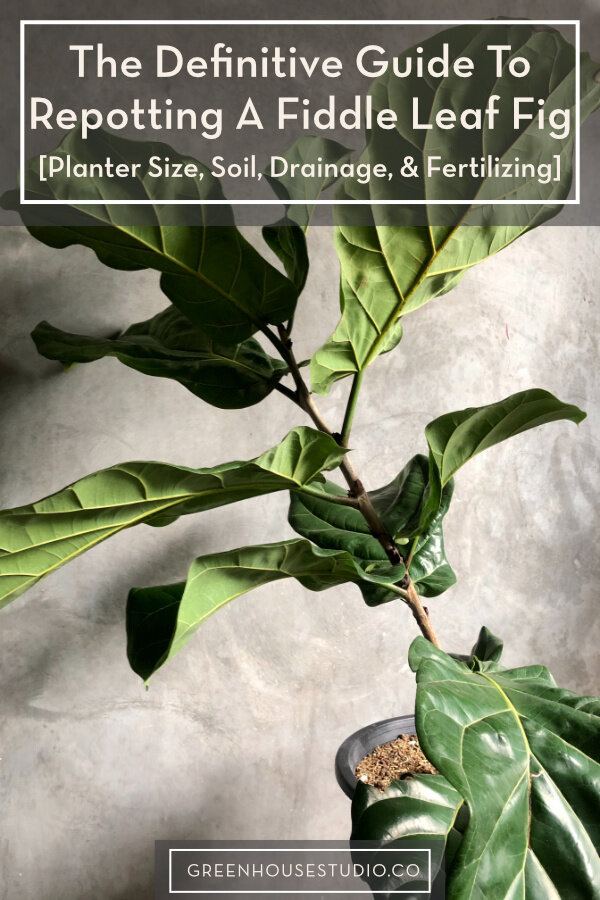To repot a fig tree, gently remove the tree from its current pot, loosen the roots, place it in a larger pot with fresh soil, and water thoroughly. Repotting helps the fig tree grow healthier and larger, as well as prevents root bound.
Fig trees should be repotted every 1-2 years, depending on their size and growth rate. Moving onto a larger pot allows the roots to spread and absorb nutrients more efficiently, supporting a stronger and more fruitful tree. It is important to choose a pot with good drainage and use a well-draining soil mixture to avoid waterlogged roots.
Maintaining the proper care and repotting schedule will contribute to the overall health and success of your fig tree.

Credit: fiddleleaffigplant.com
Choosing The Right Pot For Your Fig Tree
Choosing the appropriate pot size is crucial for the health and growth of your fig tree. When selecting a pot, there are a few factors to consider. Firstly, ensure that the pot has good drainage holes to prevent waterlogged roots.
Secondly, consider the size of the pot in relation to the current size of your fig tree. A pot that is too small may restrict root growth and lead to stunted development. On the other hand, a pot that is too large can promote excessive moisture retention and potentially cause root rot.
It is generally recommended to choose a pot that is slightly larger than the current root ball of your fig tree. This will provide enough space for the roots to spread and promote healthy growth. By carefully selecting the right pot size, you can provide optimal conditions for your fig tree to thrive.
Preparing Your Fig Tree For Repotting
Preparing your fig tree for repotting involves pruning and trimming to ensure healthy growth. Signs that your fig tree needs repotting include roots growing out of the drainage holes and a root-bound appearance. Before repotting, gently loosen the roots to promote healthy growth in the new pot.
Carefully remove the fig tree from its current pot, taking care not to damage the roots. Choose a new pot that is slightly larger and has drainage holes. Place a layer of fresh potting soil at the bottom of the new pot and position the fig tree in the center.
Fill in the gaps with additional potting soil, making sure not to pack it too tightly. Water the newly repotted fig tree thoroughly and place it in a suitable location with adequate sunlight. By following these steps, you can successfully repot your fig tree and promote its overall health and growth.
How to Repot Fig Tree : Step by Step Guide
Repotting your fig tree is an important step in its growth and overall health. To begin, gather all the necessary tools and materials. Carefully remove the fig tree from its current pot, making sure to be gentle and avoid damaging the roots.
Loosen the roots slightly to encourage proper growth. Minimize any potential root damage by following a few simple tips. Prepare the new pot by adding adequate drainage materials. Choose the right potting soil, ensuring it is well-draining and nutrient-rich. Place the fig tree in the new pot, making sure it is properly aligned and positioned.
Backfill the pot with soil, ensuring the roots are covered but not buried too deeply. Water the newly repotted fig tree, following proper watering techniques. Monitor the tree for signs of stress or overwatering, adjusting your care accordingly.
Aftercare And Maintenance Tips For Your Repotted Fig Tree
Repotting a fig tree is a crucial step in its care. After repotting, providing the right amount of sunlight is essential. Place the tree in a location where it can receive bright but indirect sunlight. Fertilizing your fig tree is equally important.
Follow a regular schedule and use suitable techniques to ensure proper nutrition. Be cautious of common issues that may arise after repotting. Monitor for signs of stress, such as wilting leaves or root rot. To prevent these problems, consider adjusting watering frequency and using well-draining soil.
Taking care of your repotted fig tree requires attention to detail, but with proper aftercare, your tree will thrive and provide you with delicious figs.
Frequently Asked Questions Of How To Repot Fig Tree
When Should You Repot A Fig Tree?
Repot a fig tree when it outgrows its current container or every 2-3 years to provide more space for growth.
What Is The Best Soil For Repotting Fig Trees?
The best soil for repotting fig trees is a well-draining potting mix rich in organic matter.
Do Fig Plants Need Big Pots?
Fig plants thrive in big pots as they require ample room for their extensive root system to grow.
What Kind Of Soil Do Potted Fig Trees Need?
Potted fig trees thrive in well-draining soil with a pH level between 6. 0 and 6. 5.
Conclusion
Repotting your fig tree is a simple yet crucial step in maintaining its health and growth. By following the steps outlined in this blog post, you can ensure that your fig tree has the necessary space, nutrients, and drainage to thrive.
Remember to choose the right time of year and container size, and be gentle when handling the roots. Providing a well-draining soil mix and monitoring the moisture levels will promote healthy root development. Additionally, regular pruning and fertilizing will help your fig tree flourish.
With proper care and attention, your repotted fig tree will reward you with abundant and delicious fruit. So, don’t hesitate to roll up your sleeves and give your cherished fig tree the fresh start it deserves. Happy repotting!

